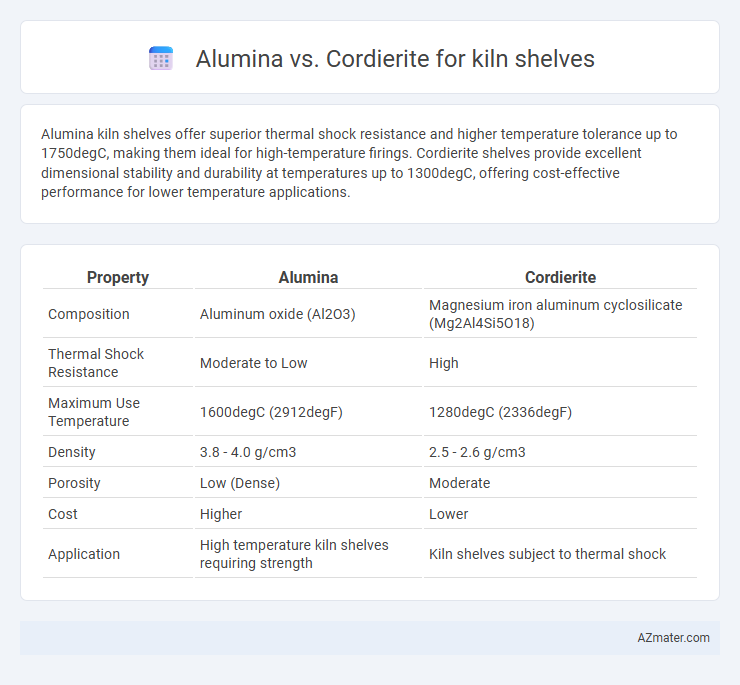Alumina kiln shelves offer superior thermal shock resistance and higher temperature tolerance up to 1750degC, making them ideal for high-temperature firings. Cordierite shelves provide excellent dimensional stability and durability at temperatures up to 1300degC, offering cost-effective performance for lower temperature applications.
Table of Comparison
| Property | Alumina | Cordierite |
|---|---|---|
| Composition | Aluminum oxide (Al2O3) | Magnesium iron aluminum cyclosilicate (Mg2Al4Si5O18) |
| Thermal Shock Resistance | Moderate to Low | High |
| Maximum Use Temperature | 1600degC (2912degF) | 1280degC (2336degF) |
| Density | 3.8 - 4.0 g/cm3 | 2.5 - 2.6 g/cm3 |
| Porosity | Low (Dense) | Moderate |
| Cost | Higher | Lower |
| Application | High temperature kiln shelves requiring strength | Kiln shelves subject to thermal shock |
Introduction to Kiln Shelves: Alumina vs Cordierite
Kiln shelves are essential components in ceramic firing, providing stable surfaces that withstand extreme temperatures. Alumina kiln shelves offer superior strength, thermal shock resistance, and durability at high firing temperatures above 1400degC, making them ideal for heavy loads and frequent firings. Cordierite kiln shelves excel in thermal shock resistance and lightweight properties but are better suited for lower temperature firings up to 1280degC and less demanding applications.
Material Composition: Understanding Alumina and Cordierite
Alumina kiln shelves are composed primarily of aluminum oxide (Al2O3), offering high thermal conductivity and exceptional resistance to thermal shock and deformation at elevated temperatures. Cordierite kiln shelves consist mainly of magnesium iron aluminum cyclosilicate (3MgO*2Al2O3*6SiO2), known for its excellent thermal shock resistance and low thermal expansion, making it ideal for rapid heating and cooling cycles. The distinct material compositions of alumina and cordierite directly impact their heat tolerance, durability, and suitability for various kiln firing processes.
Thermal Properties: Heat Resistance and Conductivity
Alumina kiln shelves offer superior heat resistance with melting points around 2072degC and exhibit low thermal expansion, minimizing warping during high-temperature firings. Cordierite shelves provide excellent thermal shock resistance due to their low thermal conductivity and expansion, making them ideal for rapid temperature changes up to about 1300degC. The choice between alumina and cordierite depends on firing temperatures and the need for dimensional stability versus shock resistance in kiln applications.
Durability and Longevity Comparison
Alumina kiln shelves offer superior durability due to their high resistance to thermal shock and chemical corrosion, making them ideal for repeated firing cycles and high-temperature operations. Cordierite shelves provide excellent thermal shock resistance and lighter weight but tend to have a shorter lifespan under extreme temperatures and heavy kiln loads. For long-term kiln use, alumina shelves generally outperform cordierite in maintaining structural integrity and extending overall shelf longevity.
Weight and Handling Differences
Alumina kiln shelves are significantly heavier than cordierite shelves due to alumina's higher density, making them more challenging to handle during loading and unloading. Cordierite shelves offer a lighter alternative, reducing the physical strain and risk of damage during handling without compromising thermal shock resistance. Weight differences influence user ergonomics and transportation logistics in kiln operations, with cordierite preferred for its ease of use in artisanal and smaller-scale firing processes.
Performance at High Firing Temperatures
Alumina kiln shelves offer superior thermal stability and resistance to warping at high firing temperatures, making them ideal for repeated use in electric and gas kilns reaching up to 1300degC or higher. Cordierite shelves provide excellent thermal shock resistance and are more affordable but may deform or degrade faster under prolonged exposure to extreme heat. For high-fire ceramics and production environments requiring durability and minimal shelf distortion, alumina consistently outperforms cordierite.
Cost Analysis: Alumina vs Cordierite Kiln Shelves
Alumina kiln shelves typically cost more upfront than cordierite shelves due to their higher purity and superior thermal resistance, making them ideal for high-temperature firings above 1300degC. Cordierite shelves offer a more budget-friendly option with good thermal shock resistance and lower density, suitable for temperatures up to 1280degC. When evaluating cost-effectiveness, alumina's longer lifespan and reduced warping often offset its higher initial price compared to the more affordable but less durable cordierite shelves.
Best Applications for Alumina Kiln Shelves
Alumina kiln shelves are best suited for high-temperature applications due to their excellent thermal stability and resistance to thermal shock, making them ideal for firing porcelain, stoneware, and other dense ceramics. Their high alumina content enhances durability and prevents warping in kilns operating above 1300degC. These shelves excel in professional studio and industrial settings where consistent performance and longevity under extreme heat are critical.
Ideal Uses for Cordierite Kiln Shelves
Cordierite kiln shelves are ideal for glass fusing and ceramics due to their excellent thermal shock resistance and low thermal expansion, preventing warping during rapid temperature changes. These shelves support delicate glass pieces, ensuring smooth heating and cooling cycles without cracking or breaking. Compared to alumina, cordierite offers superior insulation properties and cost-effectiveness for moderate-temperature firing processes.
Choosing the Right Kiln Shelf for Your Studio
Alumina kiln shelves offer superior thermal stability and high strength, making them ideal for repeated firings and heavy loads in ceramics studios. Cordierite shelves provide excellent thermal shock resistance and are typically lighter, reducing strain on kiln elements and structural supports. Selecting alumina or cordierite depends on your firing temperature range, kiln size, and frequency of use to optimize durability and performance in your studio.

Infographic: Alumina vs Cordierite for Kiln shelf
 azmater.com
azmater.com